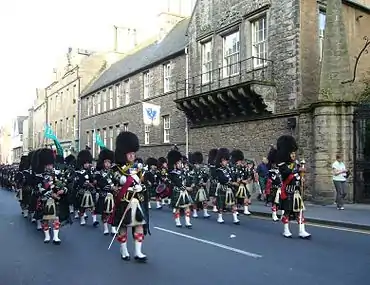Royal Scots Dragoon Guards
The Royal Scots Dragoon Guards (Carabiniers and Greys) (SCOTS DG; deutsch „Die königlich-schottische Dragonergarde“) sind das einzige schottische Kavallerie-Regiment der britischen Streitkräfte (British Forces Germany).

Geschichte
.JPG.webp)
1971 wurde in Edinburgh durch Zusammenlegung der The Royal Scots Greys (2nd Dragoons) und der 3rd Carabiniers (Prince of Wales’s Dragoon Guards) die The Royal Scots Dragoon Guards (Carabiniers and Greys) gegründet. Es setzt die Tradition der beiden vereinigten Regimenter fort und trägt deshalb den Beinamen Carabiniers and Greys und den Schriftzug „Waterloo“ im Abzeichen. In der Schlacht bei Waterloo hatten sich die Scots Greys ausgezeichnet.
Als Teil der 7th Armoured Brigade (auch als Desert Rats bekannt) war das Regiment am Zweiten Golfkrieg 1991 (Operation Desert Storm) und im Irak-Krieg 2003 (Operation Iraqi Freedom) beteiligt.
Die Royal Scots Dragoon Guards – waren seit Ende des Zweiten Weltkriegs Garnison Hohne, Standort Bad Fallingbostel (Niedersachsen, Deutschland), direkt am NATO Truppenübungsplatz Bergen stationiert und waren mit dem modernen Challenger-2-Kampfpanzer ausgestattet. Seit November 2015 ist das Regiment wieder in Schottland in Leuchars stationiert. Im November 2013 gab das Regiment seine Challenger II ab und erhielt gemäß seiner neuen Rolle als leichtes Aufklärungsregiment das Aufklärungsfahrzeug Jackal.
 Die SCOTS DG mit dem Challenger 2-Kampfpanzer beim Manöver in Basra 2008
Die SCOTS DG mit dem Challenger 2-Kampfpanzer beim Manöver in Basra 2008 Die SCOTS DG (Squadron D) mit Challenger 2 Kampfpanzer auf dem Weg zum Stützpunkt
Die SCOTS DG (Squadron D) mit Challenger 2 Kampfpanzer auf dem Weg zum Stützpunkt Die SCOTS DG (Squadron C) mit Challenger 2 Kampfpanzer bei Gefechtsübungen auf dem NATO-Truppenübungsplatz Bergen
Die SCOTS DG (Squadron C) mit Challenger 2 Kampfpanzer bei Gefechtsübungen auf dem NATO-Truppenübungsplatz Bergen
Trivia
Zur formalen Uniform der Scots Dragoon Guards gehören weiße Bärenfellmützen, die aus dem Fell von Eisbären gefertigt sind.[1]
Pipes and Drums

Das Regiment hat – wie viele schottische Militäreinheiten – eine eigene Dudelsackkapelle, die Pipes and Drums of the Royal Scots Dragoon Guards sowie eine Blaskapelle. Die Militärkapelle tourt durch alle Welt und spielt bei Wettbewerben, Platzkonzerten und Militärparaden. Ihr berühmtestes Stück ist Amazing Grace. Mit diesem Titel gelang es ihnen am 15. April 1972, die Spitzenposition der Single-Charts im Vereinigten Königreich (und auch in Australien) zu erreichen. Ihr offizieller Name auf der Single war The Pipes and Drums and Military Band of the Royal Scots Dragoon Guards. Damit waren sie die Band mit dem längsten Namen auf der Nummer-eins-Position in Großbritannien, aber auch die erste Nummer eins, auf der das traditionelle Instrument Schottlands, der Dudelsack, zu hören war.
Amazing Grace hatten die Pipes and Drums für die LP Farewell to the Greys aufgenommen – ein Abschiedsgeschenk an eins der Regimenter, das in den Royal Scots Dragoon Guards aufgegangen ist. Zur Zeit seines Hits war das Regiment in Deutschland (im ostwestfälischen Herford) stationiert, so dass die meisten Musiker gar nicht mitbekamen, dass ihr Stück im britischen Radio auf große Hörerresonanz traf. Da viele nach dem Stück fragten, wurde es letztlich von RCA als Single veröffentlicht. Innerhalb von drei Wochen war sie Nummer 1 und blieb dort fünf Wochen lang. In der Schweiz erreichte sie Platz 3 und in Deutschland Platz 11.
Die Royal Scots Dragoon Guards Band hatte in ihrem erfolgreichen Jahr 1972 zwei weitere Singles in den britischen Charts: Heykens Serenade/The Day Is Ended (höchste Platzierung: Platz 30) und zu Weihnachten eine Version von Little Drummer Boy (Platz 13).
Diskografie
Alben
- 1958: The Pipes and Drums (8th. (Lothians and Peeblesshire) Battalion und The Band of the Royal Scots Dragoon Guards)
- 1967: The Amazing Sound of the Royal Scots Dragoon Guards (als The Pipes and Drums and Military Band of the Royal Scots Dragoon Guards)
- 1971: The Legendary Amazing Grace (als The Military Band and Pipes and Drums of the Royal Scots Dragoon Guards)
- 1971: Farewell to the Greys
- 1972: Amazing Grace – Fanfares & Marches Ecossaises (als The Pipes and Drums and Military Band of the Royal Scots Dragoon Guards (Carabiniers and Greys))
- 1972: Amazing Grace (als The Military Band of the Royal Scots Dragoon Guards)
- 1973: Amazing Grace – The Original Version
- 1975: Amazing (als The Military Band & Pipes & Drums of the Royal Scots Dragoon Guards)
- 1977: The Golden Sounds of the Royal Scots Dragoon Guards
- 1978: The Royal Scots (The Royal Regiment) In Concert Mood (als Pipes and Drums and Regimental Band of the Royal Scots (The Royal Regiment))
- 1978: The Pipes & Drums & Military Band of the Royal Scots Dragoon Guards
- 1992: The Flower of Scotland
- 1998: Highland Cathedral
- 2007: Spirit of the Glen
- 2008: Spirit of the Glen – Journey
Kompilationen
- 1998: Amazing Grace
- 2010: Spirit of the Glen – The Ultimate Collection
Singles
- 1972: Amazing Grace (als The Pipes and Drums and the Military Band of the Royal Scots Dragoon Guards (Carabiniers and Greys))
- 1972: Heyken’s Serenade (Standchen) (als The Pipes and Drums and Military Band of the Royal Scots Dragoon Guards)
- 1972: The Day Is Ended (The Day Thou Gave Us Lord, Is Ended) (als The Pipes and Drums and Military Band of the Royal Scots Dragoon Guards (Carabiniers and Greys))
- 1972: Little Drummer Boy (als The Pipes and Drums and the Military Band of the Royal Scots Dragoon Guards (Carabiniers and Greys))
- 1973: The Water Is Wide
- 1973: Little Donkey (als The Royal Scots (The Royal Regiment), mit The Pipes and Regimental Band of 1st Bn)
- 1976: Largo
- 1978: Arrival (als The Military Band and Pipes of the Royal Scots Dragoon Guards)
- 1988: Highland Cathedral (als The Regimental Band, Pipes and Drums of the Royal Scots Dragoon Guards)
Quellen
- Regimental Stories The Royal Scots Dragoon Guards
- Chartquellen Alben: UK
- Auszeichnungen für Musikverkäufe: UK
- Chartquellen Singles: DE, CH, US UK1 UK2
